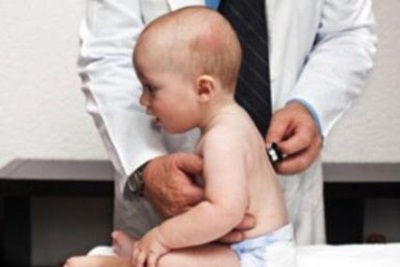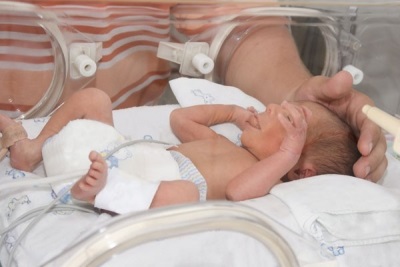Coarctation of the aorta in children and newborns
One of the frequently occurring and quite dangerous heart defects is aortic pathology, called coarctation. It represents the narrowing of the aorta, the largest vessel in the body of a person extending from the left ventricle. This defect is diagnosed in 7-15% of children with congenital heart disease. At the same time, detection of coarctation in boys occurs 2-5 times more often. Most often, aortic stenosis in children is detected at the site of its arc, but the thoracic or abdominal part of this vessel may also contract.
The reasons
In most cases, coarctation of the aorta in children develops due to a violation of the formation of this vessel, when the child is in the womb. This can contribute to such factors:
- The proximity of the arterial duct. During its closure, some of the ductal tissues draw the aortic wall into the process, which can cause both an arc break due to a pronounced contraction and a slight coarctation.
- Heredity. Aortic narrowing is detected in approximately 10–20% of babies with such chromosomal abnormalities as Shereshevsky-Turner syndrome.
Acquired coarctation, which can develop in children at an older age, is caused by trauma, inflammation, and other causes of aortic injury.
Kinds
Depending on the changes in the child’s body, there are two variants of coarctation:
- Children's;
- Adult.
Children's
A feature of this type of pathology is the unclosed arterial duct, which normally functions in the fetus in utero to discharge blood from the right heart to the aorta, bypassing the pulmonary circulation (pulmonary vessels).
Such a duct should close in the first months of life, but often this does not occur during coarctation. At the same time, blood is discharged from the aorta through the unclosed duct into the pulmonary artery, which threatens to overload the pulmonary vessels and the early development of pulmonary hypertension.
Adult
In this form, the arterial duct is usually completely closed, and the narrowing divides the aorta into two parts - the wide aorta above the site of coarctation with increased blood pressure and the extended portion of the aorta below the narrowing, in which the pressure is lowered. To compensate for the condition, bypass paths (collateral) begin to develop, delivering blood from the heart to part of the aorta above the stenosis.
In addition, the work of the left ventricle is enhanced, and the blood pressure in the vessels of the upper body increases. Since blood vessels are lowered in vessels below the belt, this activates the renal mechanism of increasing blood pressure, which is additionalIt increases the pressure of the blood vessels above the belt and increases the risk of hemorrhage.
If coarctation is the only pathology of the heart, this defect is called isolated. However, a more frequent situation is combined coarctation, when, in addition to the narrowing of the aorta, the baby has a PDA (60% of children), sinus aneurysm, septal defects, additional chords caused by hypoplasia, and other abnormalities.
Symptoms
Manifestations of this defect depend on the degree of narrowing of the aortic lumen. If it is small, the child may:
- Chest pains.
- Headaches.
- Weakness.
- Cool to the touch limbs.
- Limping during physical exertion.
Severe stenosis is manifested in newborns with anxiety, poor breast sucking, developmental delay, underweight, and pallor.With a marked narrowing and an open arterial duct, the shoulder girdle of the child develops more actively than the lower part of the body. The baby has frequent bleeding from the nose, pain in the legs, freezing of the feet, dizziness, fatigue.
In the following video, they are available and understandably talk about the symptoms of the disease and about the methods of treatment.
Possible complications
As well as valve stenosis, coarctation may be complicated:
- Aortic rupture.
- Pulmonary hypertension.
- Infectious endocarditis.
- Stroke
- Hypertension.
- Heart failure.
- Pulmonary edema.
Diagnostics
Suspected coarctation of the aorta arises when the child increases blood pressure, determines the intense pulse in his arms and barely palpable in the legs, and when the doctor listens to a soft noise over the child's aorta. To clarify the diagnosis, children spend:
- Echocardiography to visually identify the location of the narrowing.
- Phonocardiography for recording tones and noise when the heart is working.
- Electrocardiography to determine abnormalities of the heart and left ventricular overload.
- Chest X-ray to determine the state of the heart as well as the lungs.
- Catheterization of the heart and aorta to measure blood pressure above narrowing, as well as below the place of stenosis.
Treatment
This heart disease is mainly treated surgically, since no medicine can eliminate the cause of this pathology. Children with coarctation require urgent surgical intervention if:
- The index of systolic blood pressure in the lower extremities differs from that on the hands by more than 50 units.
- The defect manifested itself immediately after childbirth, and the baby had a pronounced increase in blood pressure, and decompensation of the heart’s work occurred.
In the case when coarctation is diagnosed in the first months of life, but the defect is small and the clinical manifestations are minimal, the operation is delayed until 5-6 years of age. Surgical treatment is possible for older children, but its effectiveness will suffer due to the development of severe hypertension.
The operation for coarctation may be:
- Removal of the site of coarctation followed by suturing of the ends of the aorta. This method is used for a small area of narrowing.
- Plastic surgery of the vessel, in which the child uses a prosthesis or subclavian artery. This method is in demand for a large area of stenosis.
- Installation of a shunt from a vascular prosthesis for the possibility of blood flow to bypass the narrowing.
- Balloon plastics and stent placement at the site of stenosis so that the aorta does not close after manipulation.
Forecast
If the stenosis is small, the child will have a normal life, and its duration will not be shortened. The same prognosis is given with timely surgical treatment of coarctation. When expressed narrowing without surgery, life expectancy is reduced to 30-35 years.
The coarse type of child is more dangerous than the adult because it provokes the rapid development of pulmonary hypertension. Other complications include bacterial endocarditis, stroke or aortic rupture. These causes are lethal in this case in most cases.
Coarctation of the aorta is quite a serious disease, and it certainly needs to be treated. You can learn more about the disease by watching the next video.














